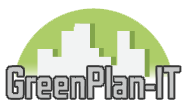Increasing the effectiveness of your city's green stormwater infrastructure
Funded by: The Environmental Protection Agency and The State Water Resources Control Board
News: Trees and Hydrology in Urban Landscapes released!
Leveraging GreenPlan-IT, the Trees and Hydrology in Urban Landscapes report seeks to build links between stormwater management and urban ecological improvements by evaluating how complementary urban greening activities, including green stormwater infrastructure (GSI) and urban tree canopy, can be integrated and improved to reduce runoff and contaminant loads in stormwater systems. This work expands the capacity for evaluating engineered GSI and non-engineered urban greening within a modeling and analysis framework, with a primary focus on evaluating the hydrologic benefit of urban trees. Insights can inform stormwater management policy and planning.
News: journal article describes GreenPlan-IT's role in contaminant reduction
Read the article "Optimal Selection and Placement of Green Infrastructure in Urban Watersheds for PCB Control" to learn how GreenPlan-IT can be used to reduce PCB contamination in urban environments.
Stormwater, while a valuable resource, can carry trash, bacteria, heavy metals, and other pollutants into our waterways, cause erosion and flooding in our urban streams, and damage habitat and property. These negative effects eventually exact a toll on the San Francisco Bay and its tributaries. Green Stormwater Infrastructure (GI), such as permeable pavement, rain gardens, tree-well planters, or bioswales, can be used as cost-effective, resilient approaches to managing stormwater at its source while delivering environmental, social, and economic benefits for your community.
GreenPlan-IT is a versatile toolset that helps aid municipalities with their efforts to place green infrastructure in the landscape and track the effectiveness of these installations.
You may either review the user manual, learn details about our case studies, or download each section separately using the Acrobat link at the base of each page.
Learn more about GreenPlan-IT: Presentation
View the animation below for a quick conceptual tour of the toolset.
Key features
Green Infrastructure is a water management approach that aims to restore watershed processes and function. In aggregate, Green Infrastructure can be an effective stormwater management approach for reducing runoff and contaminant loads from urban and developed areas. GreenPlan-IT is a GIS and modeling, planning level toolkit to aide municipalities in identifying the optimal combination of Green Infrastructure features and sites for achieving predetermined and desirable reduction outcomes at the watershed scale. By managing runoff close to its source through smart Green Infrastructure placement, we can enhance the local environment, protect public health, and improve community livability.
Project Locations
Feasibility Module (Locator Tool)
GreenPlan-IT has a customizable Arc-GIS based site locator tool for identifying, ranking, and mapping potential Green Infrastructure locations within watersheds. Outputs include maps with feasible Green Infrastructure locations, relatively ranked according to customizable weighting and ranking of data inputs.
Effectiveness Module (Modeling Tool)
The modeling tool is a hydrologic and water quality tool that quantifies reductions in stormwater and associated pollutants that result from optimal placement of Green Infrastructure in a particular watershed.
Cost/Benefit Analysis (Optimization Tool)
The optimization tool uses a cost-benefit analyses to identify the best combinations of Green Infrastructure types and number of sites within a watershed for achieving load and volume reduction goals.
Landscape Visualization (Tracker Tool)
The latest module helps municipalities to track their placement of green infrastructure in the landscape via an online tool. Once placed on the map, then the features enter a portfolio to calculate total PCB, mercury, and stormwater flow reductions.
Tool Outputs and Municipal Plans
Municipal planners can use toolkit outputs in combination with other local knowledge such as information on flood prone areas, areas for redevelopment, and educational opportunities to identify optimized Green Infrastructure placement. The toolkit outputs can be incorporated directly into municipal planning documents for longer-range adoption of strategic Green Infrastructure implementation.
